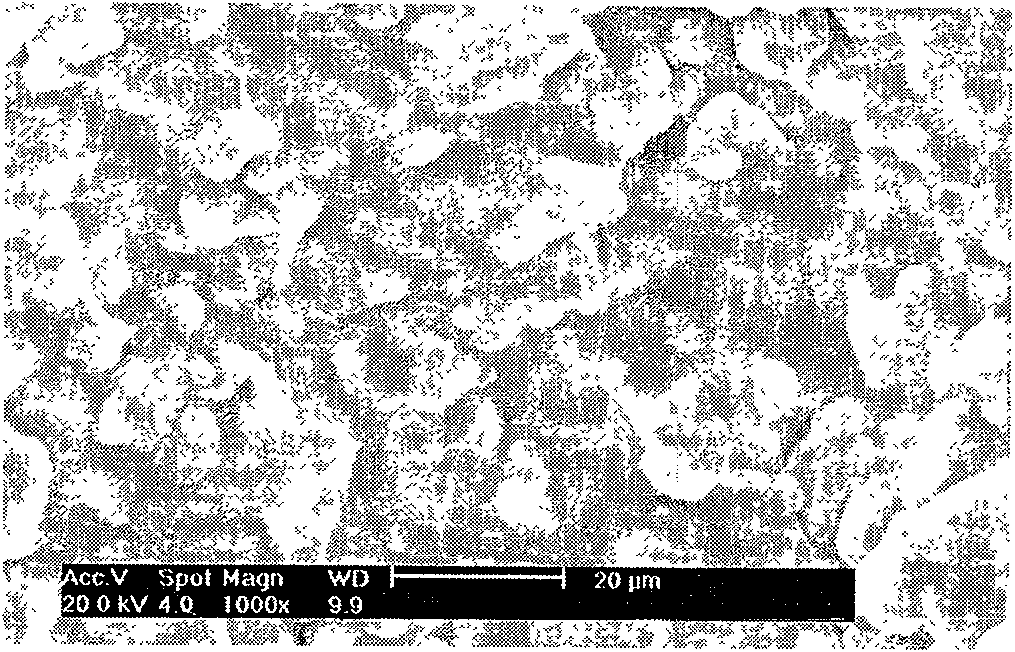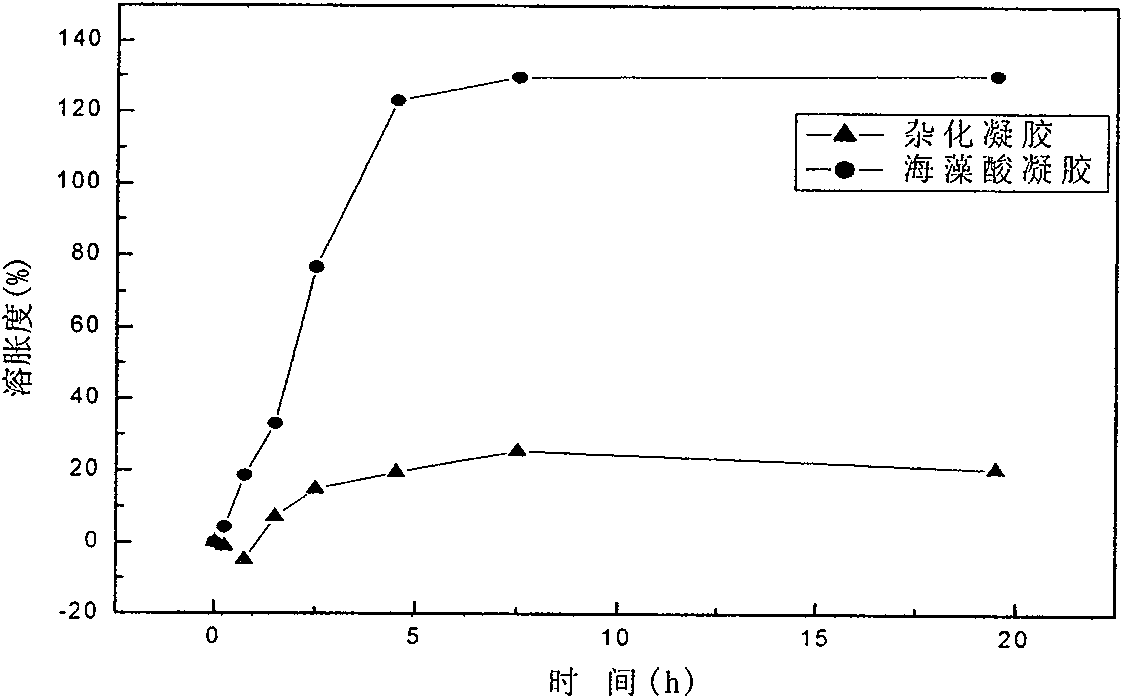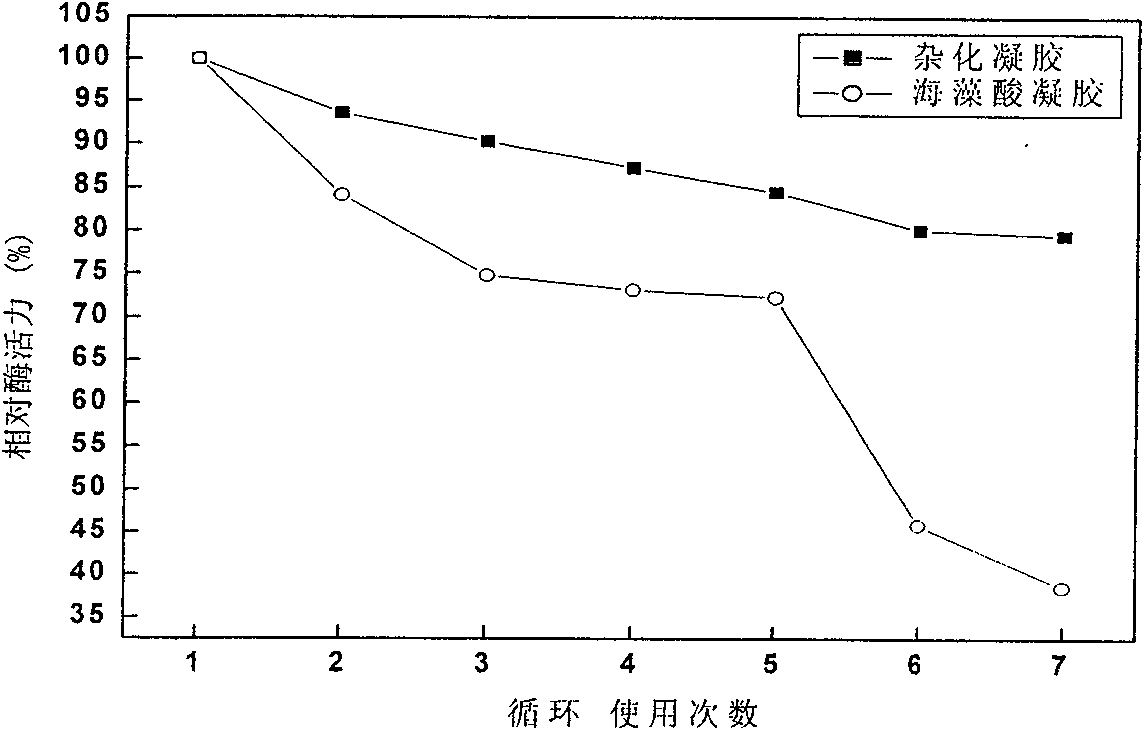Method for fixing beta-glucuronidase by alginate-calcium carbonate hybrid gel
A technology of aldolidase and hybrid gel, which is applied in the direction of immobilized on/in organic carriers, hydrolytic enzymes, etc., can solve the problems of poor effect of enzyme molecules, easy leakage of enzyme molecules, and affecting the adsorption effect, etc. Achieve the effects of simple and easy preparation process, good reusability and low swelling degree
- Summary
- Abstract
- Description
- Claims
- Application Information
AI Technical Summary
Problems solved by technology
Method used
Image
Examples
Embodiment 1
[0019] Accurately weigh 2.5mg of β-glucuronidase, dissolve in 0.05mol / L tris-hydrochloric acid (Tris-HCl) buffer solution, and dilute to 5mL to obtain 0.5mg / mL β-glucuronidase Acidase solution. Then, mix 15 mg of calcium carbonate particles with 1 ml of 0.5 mg / mL β-glucuronidase solution, adsorb for 2 hours, and centrifuge to obtain calcium carbonate particles adsorbing glucuronidase. Dissolve sodium alginate in deionized water to make a 2.0% solution, take 5ml of sodium alginate solution and mix evenly with 15mg of calcium carbonate particles adsorbing glucuronidase, and add dropwise to 0.2M calcium chloride solution with a syringe , stand still for 30min, get alginic acid-calcium carbonate hybrid gel immobilized β-glucuronidase granule, measure the glucuronidase content in the calcium chloride solution, obtain the glucuronidase in the process of gel formation The enzyme leakage rate is 9.4%. The hybrid gel particles of immobilized glucuronidase are soaked in tris-hydrochlor...
Embodiment 2
[0021] Quickly pour 100ml of 0.33M sodium carbonate solution into calcium chloride solution of equal volume and concentration, stir at high speed for 30s at room temperature, then stop stirring, let stand for 15 minutes, and centrifuge the obtained solid calcium carbonate in turn with deionized Wash with water and acetone, and dry naturally in the air to obtain micron-sized mesoporous calcium carbonate particles; dissolve sodium alginate in deionized water to make a 2.0% solution, take 5ml of sodium alginate solution and mix evenly with 15mg of calcium carbonate particles, and use The syringe was added dropwise into 0.2M calcium chloride solution and aged for 30 minutes to obtain alginic acid-calcium carbonate hybrid gel particles. Dissolve baicalin and anhydrous sodium sulfite into 0.03mol / L Tris-HCl buffer solution to prepare a solution with baicalin concentration of 0.09mol / L and anhydrous sodium sulfite concentration of 0.1% w / v, and add hybrid gel particles , store at roo...
Embodiment 3
[0022] Embodiment 3: the mensuration of cycle use stability
[0023] The cycle stability of the hybrid gel particles immobilized with β-glucuronidase prepared in Example 1 of the present invention was determined:
[0024] Dissolve baicalin and anhydrous sodium sulfite in 0.03mol / L Tris-HCl buffer solution, make baicalin concentration be 0.09mol / L, anhydrous sodium sulfite concentration be the solution of 0.1% w / v, add the solution prepared in Example 1 The granules of immobilized β-glucuronidase were subjected to the conversion reaction of baicalin under stirring conditions at 37°C, and the production amount of baicalin was determined by high performance liquid chromatography to obtain the immobilized β-glucuronidase Enzyme activity, and taking this enzyme activity as the initial enzyme activity, was defined as 100%.
[0025] The reaction solution was filtered, and the particles were washed with deionized water until there was no baicalin and baicalein in the supernatant. Th...
PUM
 Login to View More
Login to View More Abstract
Description
Claims
Application Information
 Login to View More
Login to View More - R&D
- Intellectual Property
- Life Sciences
- Materials
- Tech Scout
- Unparalleled Data Quality
- Higher Quality Content
- 60% Fewer Hallucinations
Browse by: Latest US Patents, China's latest patents, Technical Efficacy Thesaurus, Application Domain, Technology Topic, Popular Technical Reports.
© 2025 PatSnap. All rights reserved.Legal|Privacy policy|Modern Slavery Act Transparency Statement|Sitemap|About US| Contact US: help@patsnap.com



